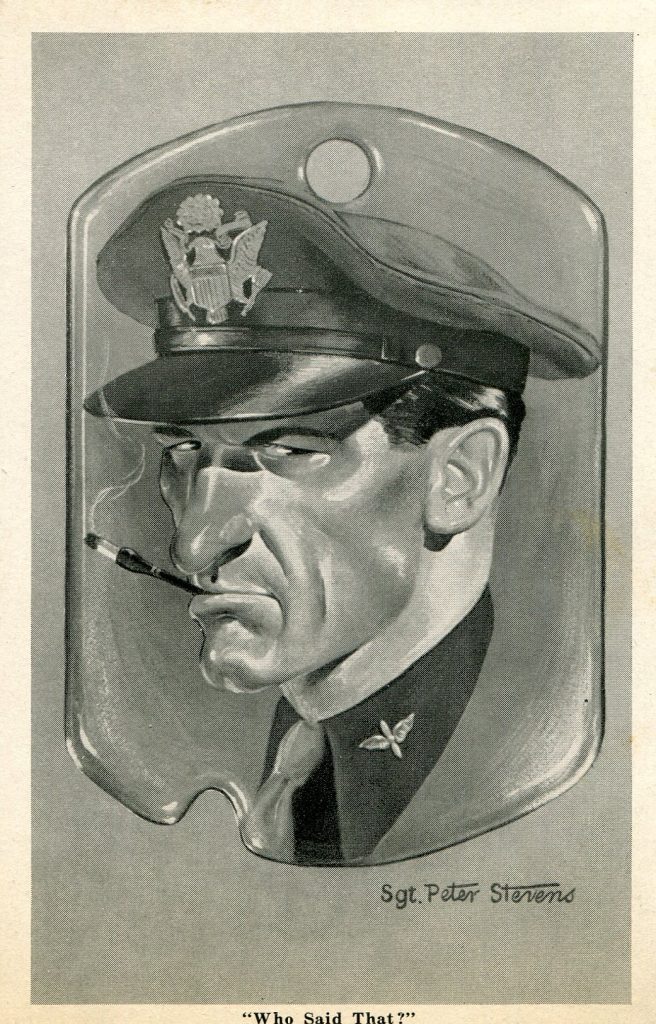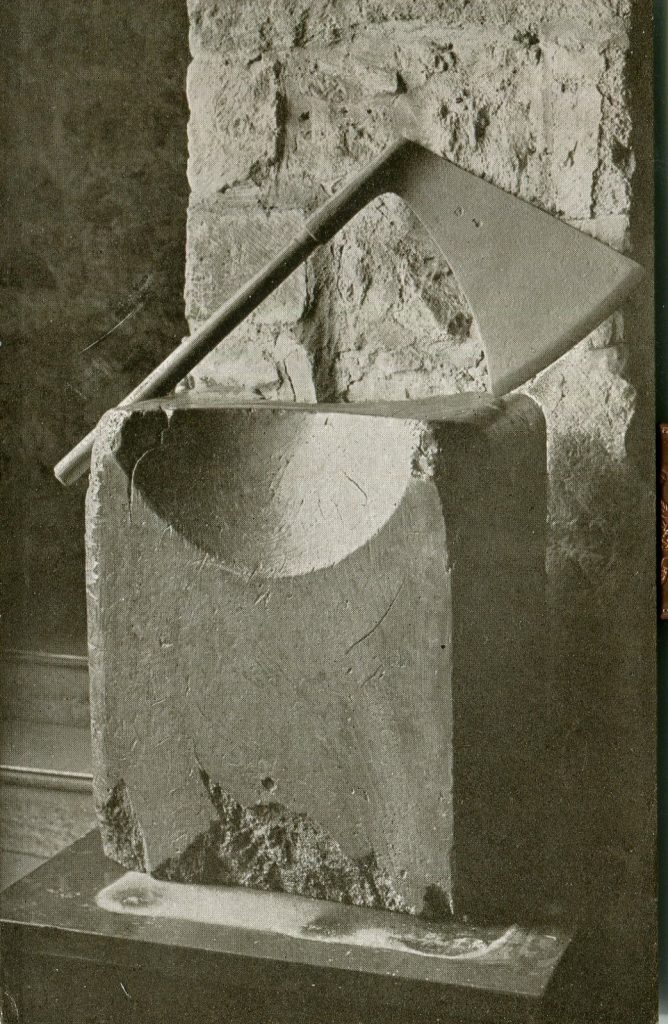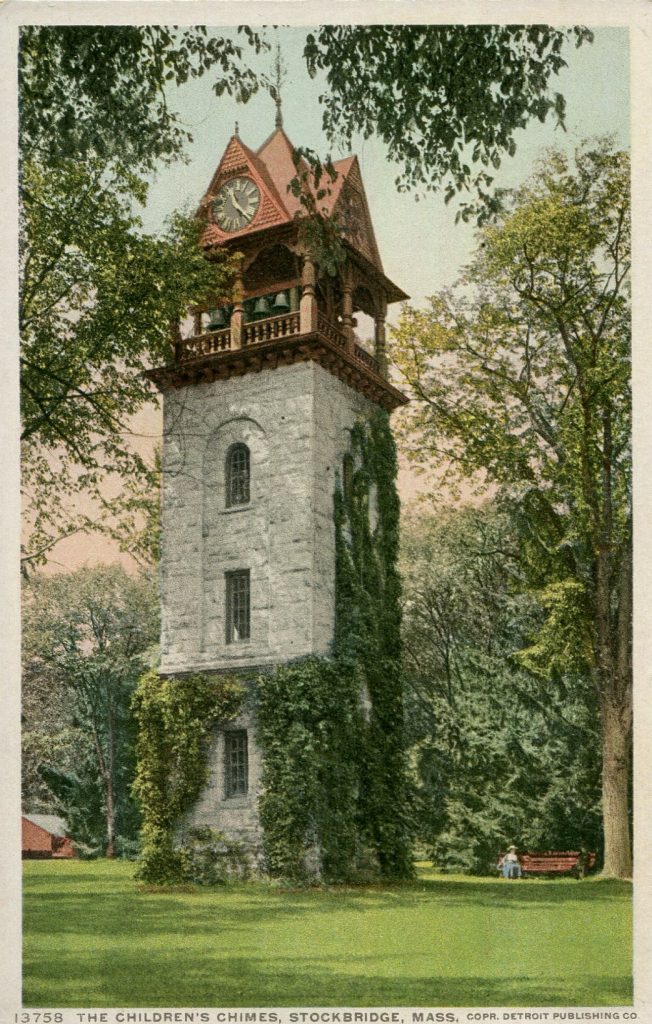
“It happens every time!”
“What happens?” you ask.
As a postcard collector, I go to shows and find cards that I haven’t seen in the previous forty years I have done the same thing. Repeatedly!
I found this card at a Virginia postcard show recently and was amused by the creative artwork and inspired design.
The artist-signed is someone calling himself Peter Stevens. Apparently, he is proud of his non-commissioned rank as he starts his signature with a Sgt.
The “frame” of his portrait is a near perfectly proportioned military “dog-tag.”
Preliminary research on Peter Stevens is in progress and you Postcard History readers will be the first to learn what is discovered.
The only information now available is that this card, entitled, “Who Said That?” is part of a series published in Danville, Virginia by the Graycraft Card Company. To date three others have been found.
* * *
From the Sublime to the Ridiculous

This Gale & Polden, Ltd. (a small publisher in London) card is one piece of a series entitled the Tower of London. (Postcard History has been unable to find how many cards are in the set, but we know of six.) This card displays two ghoulish and maybe hideous relics from a much different time – an Execution Block and Axe.
Royal inventories affirm that the axe has been in the tower since 1687, but no provenance as to the acquisition and/or procurement is appended.
There are no records concerning the block. It is however known that it was used at least once on April 9, 1747, when Lord Lovat was executed on the orders of the House of Lords.
Lovat’s given name was Simon Fraser, 11th Lord Lovat, born about 1667 in London. He was a Scotch Jacobite and chief of clan Fraser, noted for his violent family feuds and changes of allegiance.
His reckless lifestyle was a constant and in 1698 he was tried and sentenced to death but escaped punishment with a pardon from King William III. Tried again in 1701 for “rapt” and once again found guilty he left for France where he established a relationship with the Stuarts in exile.
Fraser returned to Scotland in 1703 as a Jacobite. He revealed his mission to the Duke of Queensberry and supposedly a confidant leaked the confession. On his return to France he spent ten years in prison. He escaped in 1715 and returned to Scotland where at long-last he provided good service to government.
Fraser never renounced his allegiance to the Stuarts and hoped for greater rewards when they were restored to power. He stayed active in Jacobite affairs and even when the battle of Culloden was lost he vowed to continue the campaign. Simon Fraser was eventually captured. He was condemned by the House of Lords and executed.

This beautiful Detroit Postcard shows a chime tower that stands at the north end of Main Street in Stockbridge, Massachusetts. It is not difficult to date the card, the Detroit Publishing Company’s accession number (13758) is clearly in the range of numbers assigned to production done from 1909 to 1910. The image shows the first floor of the structure covered with ivy. That is no longer the case. In a brief conversation with a local historian, I was told that the ivy has been removed several times in the last five or six decades; the latest such effort was completed circa 2000.
The official name of the tower is the Dudley Field Memorial Tower, but the locals call it the Children’s Chimes of Stockbridge. It was built in 1878 at the request of David Dudley Field II, whose grave is directly across Main Street in the Stockbridge Cemetery.
Parenthetically, Postcard History’s readers should know that Field and his brothers were quite prominent Americans. David was born in 1805, he was a U.S. Congressman and a lawyer with a colorful career. At age 20 he started his study of law in Albany, New York and later went to New York City, where he started his own practice in 1828 and remained for 40 years. He presented cases to the Supreme Court and was active in simplifying civil and criminal law code. He represented New York in Congress. He was also an active force with his voice, pen and purse in gaining a Union victory during the Civil War. He was married and widowed three times. Besides his home in New York City, he had a country place in Stockbridge, Massachusetts. His brother, Cyrus West Field was responsible for the construction of the first Atlantic Cable. Another brother, Stephen Johnson Field, was a Supreme Court Associate Justice appointed by President Lincoln in 1863.
David Field’s bequeath of the Children’s Chimes was most charming. He asked that the chimes be rung daily between, “apple blossom time and the first frost on the pumpkin.” His obituary (New York World, April 13, 1894, Page one) recalls that the tower was a gift, not only to the memory of his grandchildren, but to passersby who are lucky enough to hear the bells toll.
Apple blossoms and frost on pumpkins has been amended to June 1 to September 1, annually.
The present chime-master confesses that Three Blind Mice is one of his favorite pieces to play.
* * *
The Art of Sgt. Peter Stevens
Editor’s Staff
Sunday Odds and Ends
Part 3
The Children’s Chimes, Stockbridge, Massachusetts

This beautiful Detroit Postcard shows a chime tower that stands at the north end of Main Street in Stockbridge, Massachusetts. It is not difficult to date the card, the Detroit Publishing Company’s accession number (13758) is clearly in the range of numbers assigned to production done from 1909 to 1910. The image shows the first floor of the structure covered with ivy. That is no longer the case. In a brief conversation with a local historian, I was told that the ivy has been removed several times in the last five or six decades; the latest such effort was completed circa 2000.
The official name of the tower is the Dudley Field Memorial Tower, but the locals call it the Children’s Chimes of Stockbridge. It was built in 1878 at the request of David Dudley Field II, whose grave is directly across Main Street in the Stockbridge Cemetery.
Parenthetically, Postcard History’s readers should know that Field and his brothers were quite prominent Americans. David was born in 1805, he was a U.S. Congressman and a lawyer with a colorful career. At age 20 he started his study of law in Albany, New York and later went to New York City, where he started his own practice in 1828 and remained for 40 years. He presented cases to the Supreme Court and was active in simplifying civil and criminal law code. He represented New York in Congress. He was also an active force with his voice, pen and purse in gaining a Union victory during the Civil War. He was married and widowed three times. Besides his home in New York City, he had a country place in Stockbridge, Massachusetts. His brother, Cyrus West Field was responsible for the construction of the first Atlantic Cable. Another brother, Stephen Johnson Field, was a Supreme Court Associate Justice appointed by President Lincoln in 1863.
David Field’s bequeath of the Children’s Chimes was most charming. He asked that the chimes be rung daily between, “apple blossom time and the first frost on the pumpkin.” His obituary (New York World, April 13, 1894, Page one) recalls that the tower was a gift, not only to the memory of his grandchildren, but to passersby who are lucky enough to hear the bells toll.
Apple blossoms and frost on pumpkins has been amended to June 1 to September 1, annually.
The present chime-master confesses that Three Blind Mice is one of his favorite pieces to play.
* * *
The Art of Sgt. Peter Stevens

“It happens every time!”
“What happens?” you ask.
As a postcard collector, I go to shows and find cards that I haven’t seen in the previous forty years I have done the same thing. Repeatedly!
I found this card at a Virginia postcard show recently and was amused by the creative artwork and inspired design.
The artist-signed is someone calling himself Peter Stevens. Apparently, he is proud of his non-commissioned rank as he starts his signature with a Sgt.
The “frame” of his portrait is a near perfectly proportioned military “dog-tag.”
Preliminary research on Peter Stevens is in progress and you Postcard History readers will be the first to learn what is discovered.
The only information now available is that this card, entitled, “Who Said That?” is part of a series published in Danville, Virginia by the Graycraft Card Company. To date three others have been found.
* * *
From the Sublime to the Ridiculous

This Gale & Polden, Ltd. (a small publisher in London) card is one piece of a series entitled the Tower of London. (Postcard History has been unable to find how many cards are in the set, but we know of six.) This card displays two ghoulish and maybe hideous relics from a much different time – an Execution Block and Axe.
Royal inventories affirm that the axe has been in the tower since 1687, but no provenance as to the acquisition and/or procurement is appended.
There are no records concerning the block. It is however known that it was used at least once on April 9, 1747, when Lord Lovat was executed on the orders of the House of Lords.
Lovat’s given name was Simon Fraser, 11th Lord Lovat, born about 1667 in London. He was a Scotch Jacobite and chief of clan Fraser, noted for his violent family feuds and changes of allegiance.
His reckless lifestyle was a constant and in 1698 he was tried and sentenced to death but escaped punishment with a pardon from King William III. Tried again in 1701 for “rapt” and once again found guilty he left for France where he established a relationship with the Stuarts in exile.
Fraser returned to Scotland in 1703 as a Jacobite. He revealed his mission to the Duke of Queensberry and supposedly a confidant leaked the confession. On his return to France he spent ten years in prison. He escaped in 1715 and returned to Scotland where at long-last he provided good service to government.
Fraser never renounced his allegiance to the Stuarts and hoped for greater rewards when they were restored to power. He stayed active in Jacobite affairs and even when the battle of Culloden was lost he vowed to continue the campaign. Simon Fraser was eventually captured. He was condemned by the House of Lords and executed.

This beautiful Detroit Postcard shows a chime tower that stands at the north end of Main Street in Stockbridge, Massachusetts. It is not difficult to date the card, the Detroit Publishing Company’s accession number (13758) is clearly in the range of numbers assigned to production done from 1909 to 1910. The image shows the first floor of the structure covered with ivy. That is no longer the case. In a brief conversation with a local historian, I was told that the ivy has been removed several times in the last five or six decades; the latest such effort was completed circa 2000.
The official name of the tower is the Dudley Field Memorial Tower, but the locals call it the Children’s Chimes of Stockbridge. It was built in 1878 at the request of David Dudley Field II, whose grave is directly across Main Street in the Stockbridge Cemetery.
Parenthetically, Postcard History’s readers should know that Field and his brothers were quite prominent Americans. David was born in 1805, he was a U.S. Congressman and a lawyer with a colorful career. At age 20 he started his study of law in Albany, New York and later went to New York City, where he started his own practice in 1828 and remained for 40 years. He presented cases to the Supreme Court and was active in simplifying civil and criminal law code. He represented New York in Congress. He was also an active force with his voice, pen and purse in gaining a Union victory during the Civil War. He was married and widowed three times. Besides his home in New York City, he had a country place in Stockbridge, Massachusetts. His brother, Cyrus West Field was responsible for the construction of the first Atlantic Cable. Another brother, Stephen Johnson Field, was a Supreme Court Associate Justice appointed by President Lincoln in 1863.
David Field’s bequeath of the Children’s Chimes was most charming. He asked that the chimes be rung daily between, “apple blossom time and the first frost on the pumpkin.” His obituary (New York World, April 13, 1894, Page one) recalls that the tower was a gift, not only to the memory of his grandchildren, but to passersby who are lucky enough to hear the bells toll.
Apple blossoms and frost on pumpkins has been amended to June 1 to September 1, annually.
The present chime-master confesses that Three Blind Mice is one of his favorite pieces to play.
* * *
The Art of Sgt. Peter Stevens
A “wonderful” vignette about the tower in Stockbridge MA – been there but have never knowingly viewed the tower. The Sergeant is ho-hum. There must be more info somewhere. The axe and block are indeed horrid. Some years ago I toured the Tower of London. The guide was a raconteur who said that when Anne Boleyn was executed, her eyes fluttered as her head fell from the block and lay on the ground. Another execution took 3 swings of the axe, not hard to understand given the shape and size of that implement. I acknowledge both of these executions predate… Read more »
All of these are FIRST CLASS and really so interesting and unusual. Thank you.
Good information! I may be mistaken, but it appears that that is the Army Air Corps insignia pin on the sergeant’s collar. Is it possible that this is depicting RAF pilot Peter Stevens, whose life is chronicled in his son Marc’s book Escape, Evasion and Revenge? https://www.goodreads.com/book/show/12091880-escape-evasion-and-revenge
Your observation about the collar insignia is correct, that is an Army Air Corps pin. As for the name Peter Stevens, there is no reason to believe that a British military (RAF) pilot would be wearing an American military insignia. Furthermore, in the text there is mention of other similar cards that were found, each has identical signatures in nearly identical places in the art. This suggests that it is the signature of the artist, not an identification of the person pictured.
I vote for the clock tower story as wonderful, the Tower of London account as horrid, and the Sgt. Peter Stevens segment as ho-hum.